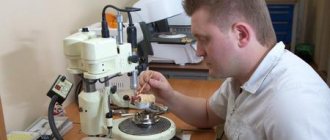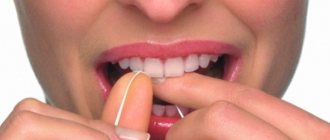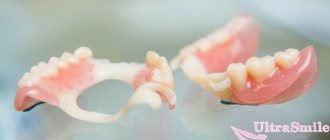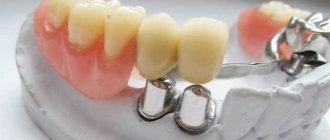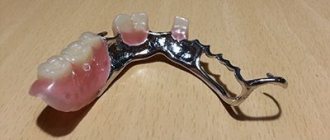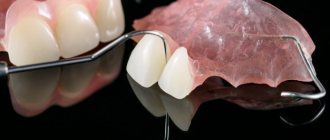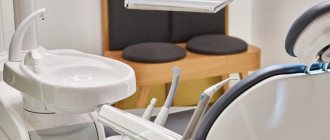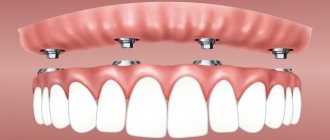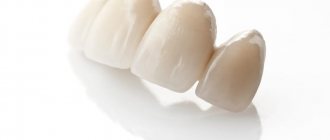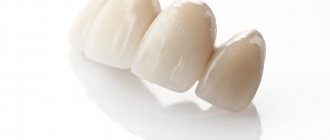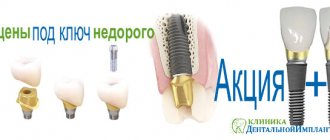- Peculiarities
- Indications
- Contraindications
- Materials
- Kinds
- Advantages and disadvantages
- Stages of treatment
- Front and chewing teeth
- Alternative Methods
- Life time
- Care
- Advantages of the ROOTT Clinic
- Prices
- Work examples
- Doctors
- Reviews
Among the methods of prosthetics, metal-ceramic dental prostheses have become classics. Patients choose these designs for their strength, durability, and optimal quality-price ratio. In the network of ROOTT clinics in Moscow, dental prosthetics are performed using new generation metal-ceramics (Ivoclar, Noritake). The high quality of the ceramic mass and the choice of colors allow us to produce reliable structures that are indistinguishable from the patient’s teeth. Metal-ceramics are used for single crowns, bridges of varying lengths, partial and complete dentures supported by teeth or implants.
- When to use:
Missing or decayed teeth - Installation time:
from 1 day (depending on the prosthetic option) - Type of anesthesia:
local anesthesia - Materials:
metal, ceramics - Features:
step-by-step treatment possible - Age restrictions:
from 18 years old (in our clinic)
Design Features
Orthopedic systems made of metal-ceramics have a reliable frame made of a metal alloy, lined with ceramic mass, close in color to natural enamel. The coating is applied in layers - each layer is exposed to high temperature (baked). This ensures strong adhesion of materials and good aesthetics of the prosthesis - the risk of chipping the lining is reduced to zero.
Advantages
Possessing high strength, they differ:
- Durability. They serve for about 15 years.
- Absolute safety. The production of metal frames from precious metal alloys makes it possible to achieve optimal biocompatibility with dental tissues, eliminating the possibility of oxidation and the occurrence of allergic reactions.
- Versatility. Crowns are ideal for both simple prosthetics and complex restorations with a long-lasting prognosis. Metal ceramics optimally replicate the structure of natural teeth, allowing you to create a beautiful and natural smile.
How is cermet used?
Metal-ceramic crowns are used for deformation or disease of dental tissues. Treatment begins with diagnostic procedures and the manufacture of a metal frame. The frame fully matches the contours of the tooth and is formed from alloys of precious metals - gold and platinum, gold and palladium, etc. A porcelain veneer is applied to the metal frame, the shade of which is selected depending on the color of your own teeth. Thus, the metal-ceramic crown imitates natural teeth and is highly durable. Modern restoration technologies make it possible to restore even completely damaged teeth. High-quality metal ceramics, made in laboratory conditions, are not subject to cracking and retain their color even under the influence of tea, coffee, and tobacco.
We have everything you need to help our patients smile more often and feel great!
Metal-ceramic prosthetics can be called a classic of modern dentistry. This service is very popular because it gives high-quality, predictable results for little money. Let's look at the pros and cons of a porcelain-coated metal prosthesis, how long it will take to install it and, most importantly, what is the price of a turnkey metal-ceramic crown at the Lucky Smile clinic.
What are metal-ceramic dental crowns?
This term refers to prostheses consisting of two parts:
- durable metal alloy frame;
- ceramic cladding.
The ceramics are applied in layers, firing each layer at very high temperatures so that both parts of the structure are securely connected to each other. The crown is both durable and quite aesthetic, because the ceramic layer is visually similar to natural enamel.
The metal-ceramic prosthesis is universal, and this is its main advantage. At a relatively low cost, it performs its functions perfectly. On average, such a crown lasts 8 - 10 years.
Contraindications
Relative
the procedure can be carried out with extreme caution
- Inflammation in the active phase;
- mixed bite (possibly after orthodontic treatment;);
- teeth of different sizes;
- teeth too small.
Absolute
the procedure is strictly prohibited
- Bruxism;
- thinned enamel;
- weak support units;
- periodontal pathology;
- tooth mobility;
- allergy to metal.
Material
Different materials are used for the frame:
- Metal alloys
(chromium-nickel, cobalt-chromium) - such prosthetics combine efficiency, strength, and wear resistance. But the presence of nickel, chromium or cobalt in the structure increases the risk of developing allergies and contributes to the appearance of a bluish stripe at the border of the prosthesis with the gum, due to metal oxidation. - Alloys of noble metals
(platinum, gold, palladium) - allow you to make an aesthetic prosthesis of precise anatomical shape, do not oxidize, and do not cause allergic reactions. - Titanium
- structures made from this material are distinguished by precise edge fit, are completely biocompatible, and do not react to thermal or chemical influences.
The type of metal used as a base affects the performance of the orthopedic system. If there are doubts regarding the material of the prosthetics, at the RUTT clinic you can take a small sample of the metal for an allergy test. When installed on implants, the prosthesis is made of titanium of the same grade as the implant system.
Main characteristics of prostheses
Dental prostheses (bridges, crowns, etc.) are designed to restore the functionality and appearance of a lost tooth. As a rule, the structure consists of a frame made of metal and cladding. The outer layer of the prosthesis is a ceramic coating.
For the manufacture of the frame, not pure material is often used, but an alloy of cobalt, titanium, chromium and nickel; precious metals in the form of gold, palladium or platinum can also be used. Such frames will be more expensive, however, the likelihood of an allergic reaction is minimal.
Metal-ceramic dentures come in different types, so the specialist selects the most suitable option individually for each patient. Products are manufactured exclusively from impressions taken from the clinic client’s teeth.
Types of metal-ceramic prostheses
All known methods of prosthetics are divided into 3 types - classic removable and fixed structures, dentures on implants (conditionally removable).
- Removable
dentures made of metal-ceramics are fixed to supporting units using clasps (hooks), attachments (micro-locks) or telescopic crowns. A popular representative is the clasp prosthesis, for the attachment of which you need at least two points of support (your teeth or implants). - Fixed
metal-ceramic dentures (crowns, bridges of varying lengths) are fixed to abutment teeth or implants. Use a cement or screw (when installing on abutments) method of fastening.
The type of orthopedic system is selected in accordance with the nature of the damage and the extent of the defect.
Cost of services
The dental clinic "Doctor Martin" is one of the dentists that provides prosthetics on metal-ceramic crowns at low prices, despite the high level of service provided.
The clinic’s website provides information not only about the services provided, specialists and patient reviews, but also about the prices in force at the center. The cost of metal-ceramic dentures depends on several factors, so the prices indicated in the price list are average. The final cost is announced at the initial appointment before treatment begins.
You can make an appointment with Dr. Martin dental specialists for prosthetics at any time on the website, or by contacting the clinic’s consultants by phone.
Pros and cons of metal-ceramic prostheses
Advantages
- Durability - withstands high chewing loads;
- aesthetics - the color of the ceramic cladding is identical to natural enamel;
- Manufacturing of the prosthetic system takes 7-14 days;
- hygiene - metal ceramics do not accumulate bacterial plaque;
- ease of care;
- low price.
Flaws
- Volumetric preparation of supporting units, depulpation is required;
- some metals can cause allergies and oxidize upon contact with saliva (the exception is a frame made of precious metals);
- can injure the enamel of opposite, neighboring units;
- when the gums recede, the frame may become visible through the ceramic layer (a dark stripe at the gingival margin);
- Not recommended for installation on anterior teeth due to the “gray neck” effect.
What is metal-ceramic prosthetics?
Metal-ceramic prostheses are structures that are a frame, the base of which is made of metal. The top coating is made of ceramic. Such designs allow solving the problem of edentia in patients of any age. They perfectly restore chewing function and also have an excellent appearance.
When creating a denture, an impression is created, which the dental technician subsequently works on. Using an impression, a frame for future crowns is modeled, which is then tried on. If it fits perfectly, the surface is covered with a ceramic layer, which is then protected with glaze. The prosthesis is ready - all you need to do is install it.
Advantages
Today, dental prosthetics using metal-ceramics is the most popular among patients. This is due to the many advantages that metal-ceramic structures have:
- extremely aesthetic appearance. The ceramic coating perfectly imitates the color of tooth enamel. It is almost impossible to visually distinguish a crown, which ensures psychological comfort;
- high degree of hygiene. The material is not affected by microbes and bacteria present in the oral cavity;
- full biological compatibility. If the prosthetic technique is performed correctly, the installed structures do not have a harmful effect on the condition of the gums;
- durability. Ceramic metal is very durable, which allows it to withstand impressive loads. Due to this, the service life of the prostheses is very long. According to WHO, it is 7-8 years, but high-quality structures successfully serve for 15 years or even more;
- high functionality. When eating, the patient does not feel the slightest discomfort;
- optimal cost. Prices for dental prosthetics with metal-ceramics in Moscow are lower than for the installation of zirconium dentures. This option is one of the most optimal in terms of price/quality ratio. You can find out exactly how much the services cost by studying the price list below or by calling.
Stages of prosthetics
The prosthetic procedure includes the following steps:
- Diagnostic
- dental examination, diagnostics (orthopantomogram, CT scan), hygienic cleaning, treatment of teeth and gums (according to indications). - Preparatory
- preparation of supporting units (preparation, filling of canals, strengthening of roots with an inlay or pin (if necessary), giving the stump the desired shape), installation of a temporary protective structure. - Laboratory
- the stages of manufacturing a metal-ceramic prosthesis in dentistry do not differ from the creation of orthopedic systems from other materials:
- taking impressions of the patient’s jaws;
- making a plaster model;
- wax modeling of the structure;
- production of metal-ceramic prosthesis with polishing and grinding.
- Fitting and installation
- after fitting, the orthopedic system is fixed to the prepared supports with cement.
The metal-ceramic structure is attached to the abutment (adapter between the implant and the supragingival part) using the screw method or composite cement.
Preparation
Once the patient's teeth are healthy and clean, the specialist will schedule an appointment to perform the preparation. The essence of the manipulation is to grind the natural crown under the installed prosthesis. This procedure is necessary for the natural appearance of an artificial tooth, since the product has a significant thickness.
Only after the grinding is completed can the specialist take an impression to make a custom crown.
At the preparation stage, the shade of the prosthesis and the characteristics of the materials from which it will be made are also determined.
Features of prosthetics of anterior and chewing teeth
Metal-ceramic orthopedic systems are used to replace any group of teeth. Installation of metal ceramics on the front incisors takes into account the characteristics of the frontal zone. Impeccable aesthetics will be ensured by a frame made of precious metals. To avoid a blue margin at the gingival margin, dentures with a shoulder mass or shoulder are used. The designs have an increased ceramic layer; the cladding does not end at the base, but is folded over to cover the metal. This improves the aesthetics of the orthopedic system in the cervical area - the metal does not show through the gum, the prosthesis looks natural even when the gingival margin subsides.
Prosthetics of molars is performed using standard technology - strength and functionality are important for the chewing zone, aesthetics takes second place here.
Alternative options
In terms of strength and durability, metal-ceramics are superior to zirconium oxide. At the same time, zirconium structures look more aesthetically pleasing, do not cause allergies, and are suitable for the restoration of any group of teeth - front incisors, molars, premolars. Another option is metal composite systems. Their advantage is that if the composite veneer is damaged, the prosthesis can be restored directly in the patient’s mouth. A relative disadvantage of the designs is the change in color of the composite due to frequent consumption of drinks and foods with dyes (tea, coffee, wine, etc.).
All-ceramic bridge Metal-free aesthetic prostheses, well suited for the anterior group of teeth
Zirconium bridge Aesthetic, durable zirconia bridge for anterior and posterior teeth
Clasp dentures A plastic frame on a durable metal arch, simulating gum, with tooth crowns inserted into it
Disadvantages of removable prosthetics
Complete removable dentures have a fairly large number of disadvantages, even though modern designs have become much more comfortable than their predecessors. Among the main ones are the following:
- insufficiently good fixation in the oral cavity,
- relative aesthetics, especially after several years of wear,
- massiveness and blocking of the palate, so the taste of food often changes,
- prostheses do not stop the process of bone tissue atrophy,
- over time, the dentures stretch due to bone atrophy and the characteristics of the materials used, which means they require frequent relining and the use of additional means for fixation (cream, dental glue),
- dentures often rub the gums, causing ulcers and pain, which again requires the use of special products,
- long-term addiction and the need to follow a diet and perform special exercises to normalize diction.
Alternatives to removable dentures
Expert opinion
Chorny Stanislav Vladimirovich Orthopedic dentist Work experience 19+
“Removable dentures are best viewed as a temporary method of restoring teeth. Such dentures put pressure solely on the gums - the bone tissue does not receive chewing load, which means it atrophies and sag along with the gums. Therefore, the design will have to be frequently re-positioned (adjusted) to achieve better comfort and a high-density fit.”
According to statistics2, only about 40% of patients know that removable dentures do not stop the process of jawbone atrophy. Moreover, more than half would have refused the installation of removable structures in favor of dental implantation if they had initially known about this consequence.
Therefore, it is worth remembering that the long absence of teeth leaves its mark on the condition of the bone tissue - in 90% of all situations there is bone atrophy caused by a long absence of chewing load. This means that with complete edentia there are restrictions on the choice of implantation method: the classical approach is difficult due to the need to increase bone volume. Therefore, the choice falls on one-stage implantation methods, which can be carried out without bone grafting, as well as with the installation of a prosthesis on the 3rd day.
All-on-4 technology
For this protocol, only 4 dental implants are used. But the method has certain limitations: its use is justified only with a slight reduction in the volume of the jaw bone, since in conditions of limited space four supports may not be enough to support a complete denture. The method belongs to the group of one-stage implantation protocols, so the prosthesis is installed in up to 3 days.
Learn more about the all-on-4 protocol >>>
All-on-6 technology
This protocol uses 6 implants. Due to the increase in the number of supports (compared to the method of prosthetics on 4 implants), the prosthesis is held more securely, which makes it possible to use this protocol when reducing the volume of the jaw bone to a moderate degree. Prosthetics with a fixed structure is also carried out within up to 3 days.
Learn more about the all-on-6 protocol >>>
Basal implantation – BASAL COMPLEX
This method allows you to restore lost teeth of the entire row, even in the presence of acute bone atrophy. To do this, install from 8 to 12 pcs. dental implants of a special design - they are fixed in the deep parts of the bone tissue, more durable and sterile. The prosthesis is installed immediately (usually on day 3), which allows for additional stabilization of the implants.
Read more about basal implantation technology >>>
1 Statistics are provided by the publishing house Kommersant.ru 2 Research was carried out at the Institute of Dental Implantology (USA).
Features of care
Article Expert
Popkov Sergey Yurievich Dentist-orthopedist, doctor of the highest category
Work experience: more than 13 years
Prices
Free online consultation with a dentist
| Service | Price |
| Installation of a metal-ceramic crown (Germany Ivoclar, cobalt-chrome) | from 15,000 rub. |
| Installation of a metal-ceramic crown on a single one-stage implant of the ROOTT system - stage II, cement fixation (SHOFU ceramics, Japan) | from 23,000 rub. |
| Installation of a metal-ceramic crown based on a bio-alloy - gold (Ivoclar Germany + cost of material according to the certificate) | from 25,000 rub. |
| Installation of a metal-ceramic crown on a single one-stage implant of the ROOTT multi-unit system with screw fixation - stage II (SHOFU ceramics, Japan) | from 28,000 rub. |
| Installation of a metal-ceramic crown on a classic implant of the ROOTT system (ceramics IVOCLAR, Germany, cobalt-chrome), cement fixation | from 28,000 rub. |
| Installation of a metal-ceramic crown on a classic implant of the ROOTT system (SHOFU ceramics, Japan, cobalt-chrome), cement fixation | from 30,000 rub. |
| Installation of a metal-ceramic crown on a classic implant of the ROOTT multi-unit system with screw fixation (ceramics IVOCLAR, Germany, cobalt-chrome) | from 32,000 rub. |
| Installation of a metal-ceramic crown on a classic implant of the ROOTT multi-unit system with screw fixation (SHOFU ceramics, Japan, cobalt-chrome), cement fixation | from 34,000 rub. |
| Installation of a metal-ceramic crown on a classic implant of the Nobel system (Sweden, Nobel Biocare) with cement fixation | from 40,000 rub. |
| Installation of a metal-ceramic crown on a classic implant of the Nobel system (Sweden, Nobel Biocare) with screw fixation | from 44,000 rub. |
| Installation of a complete metal-ceramic bridge prosthesis on one-stage implants of the ROOTT system on a metal frame, 1 jaw, cemented fixation | from 210,000 rub. from 250,000 rub. promotion |
| Installation of a complete metal-ceramic bridge prosthesis on one-stage implants of the ROOTT multi-unit system with screw fixation, 1 jaw, metal frame | from 230,000 rub. from 270,000 rub. promotion |
Consultation and diagnostics are free!
All prices Promotions
Now let's take a look at the main advantages of structures made of metal-ceramics:
• The aesthetic indicators of such prostheses are not the highest, but they are sufficient for the artificial crowns to look “organic” in the mouth. In other words, the denture will be very similar to a real tooth; and only an experienced person can recognize the presence of an artificial structure. • Of course, durability should be noted. Metal-ceramic dentures are reliable and durable. They can withstand the stress created by chewing. The metal-ceramic technique makes it possible to build bridge-like structures. • Installation of metal-ceramic crowns is cheaper than ceramic and, especially, zirconium crowns.
From here we see the optimal option for metal-ceramic prosthetics: restoration of chewing teeth and production of bridges. In any case, the final decision must be made in consultation with a dentist. Prosthetics will be preceded by therapeutic treatment.
Work examples
All works
Restoring chewing function with metal-ceramic crowns
Re-prosthetics with metal-ceramic crowns
Manufacturing of metal-ceramic fixed bridge prosthesis
Tooth restoration with a metal-ceramic crown
All works
Sign up for a consultation
three ROOTT specialists + diagnostics as a gift
Do metal and ceramic prostheses have contraindications?
The procedure for restoring teeth using prosthetics involves long-term manipulations with the installation of foreign materials into natural tissues, so there cannot be any contraindications.
It is not recommended to place metal-ceramic crowns in patients:
- before the age of 21, since the process of formation of teeth and jaw arch has not yet been completed before this period;
- with the absence of three or more teeth located nearby (installation of a removable denture is desirable);
- with severe bite pathologies or other deviations of occlusion;
- those who are allergic to metal alloys, or to any specific material used to make the crown (individual selection of materials is possible);
- with the development of severe osteoporosis;
- suffering from complex mental illnesses or diseases of the central nervous system.
Dental restoration using metal-ceramic crowns is not recommended for pregnant or lactating women, and patients with diagnosed inflammation of the oral cavity or during exacerbation of systemic diseases.
